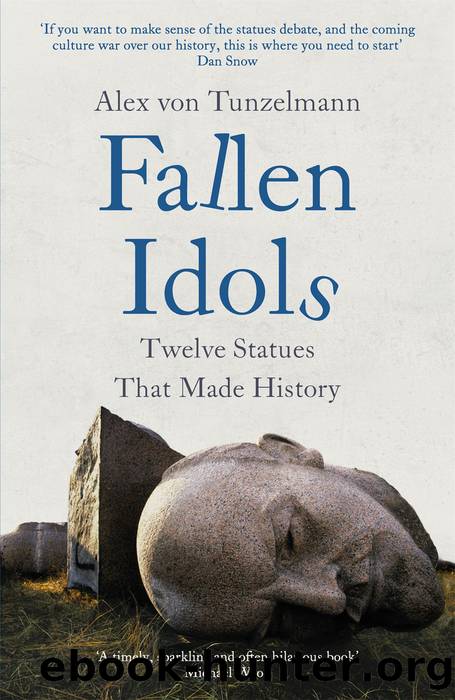Fallen Idols: Twelve Statues That Made History by Alex von Tunzelmann

Author:Alex von Tunzelmann [Tunzelmann, Alex von]
Language: eng
Format: epub
Tags: History, General, Social History, Architecture, Buildings, Landmarks & Monuments, Social Science, Slavery, Art, Political Science
ISBN: 9781472281890
Google: spIEEAAAQBAJ
Publisher: Hachette UK
Published: 2021-07-07T19:00:00+00:00
10Dedicated to a Lost Cause
Robert E. Lee
Location: New Orleans, Louisiana, USA
Put up: 1884
Pulled down: 2017
Even when he was alive, Robert E. Lee had a monumental look to him. As a cadet at West Point, he had been nicknamed âMarble Manâ for his unflappable composure. This was apt: he went on to become the most memorialized of all Confederate figures, with hundreds of statues dedicated to him. Most were raised decades after his death. It is often said that history is written by the victors. This is a story of how it was rewritten by the losers.
On 22 February 1884, a gathering of thousands was planned in Tivoli Circle, New Orleans. Almost two decades after the Confederacy had been defeated, some of its remaining sympathizers were dedicating one of the first statues of its most celebrated general, Robert E. Lee. Guests included Jefferson Davis, the former president of the former Confederacy.
As the crowd filled the seats, the sky darkened. Just as the ceremony was about to begin, a storm burst forth, with sheeting, torrential rain. One disappointed observer reported that the artillery salute could not compete with âHeavenâs artilleryâ, with interesting implications for which side he thought Heaven might be on. The crowd fled. The ceremony was abandoned.1
A few hours later, the Robert E. Lee Memorial Association met at the Washington Artillery Hall to try to salvage the day. Justice Charles E. Fenner, the association president, had written a florid and amazingly long oration to deliver in front of Leeâs statue. Had the rain not deterred the crowds, they would have been treated to around two hours of Judge Fennerâs speech. Fenner began by tracing General Leeâs heritage all the way back to the Middle Ages: Launcelot Lee, who âlanded with the conquerorâ, Lionel Lee, who âfought with Coeur de Lionâ, Richard Lee, âa cavalier of Charles the Firstâ, and so on.
Fenner took a common charge head on. âWhat do we do here today; erecting a monument to a deserter or a traitor?â Far from it, he argued: âLee loved the Union.â Fenner recounted a one-sided military history of the Civil War, exalting the Confederacy, harking back to more of the chivalry that had apparently descended to Lee from a fantasy Arthurian version of medieval England. At last, he concluded that Leeâs failure was really success â noting that Hannibal and Napoleon had also ended their careers in defeat. Lee, he claimed, was âthe highest type of gentleman . . . It is fitting that monuments should be erected to such a man.â
The mayor of New Orleans responded with yet more gushing praise, though he concluded â rhetorically â that Lee required no statue: âhis deeds are his monument, and they will survive and continue in remembrance long after this marble shall have crumbled into dust.â2
Unwittingly, the mayor had hit upon the point. If Leeâs virtues were so universally accepted, if the cause of the Confederacy was so noble, what was the need for all this justification?
The fact was that neither
Download
This site does not store any files on its server. We only index and link to content provided by other sites. Please contact the content providers to delete copyright contents if any and email us, we'll remove relevant links or contents immediately.
Kathy Andrews Collection by Kathy Andrews(11706)
The remains of the day by Kazuo Ishiguro(8785)
Paper Towns by Green John(5061)
Spare by Prince Harry The Duke of Sussex(5052)
The Body: A Guide for Occupants by Bill Bryson(4946)
Industrial Automation from Scratch: A hands-on guide to using sensors, actuators, PLCs, HMIs, and SCADA to automate industrial processes by Olushola Akande(4909)
Machine Learning at Scale with H2O by Gregory Keys | David Whiting(4096)
Be in a Treehouse by Pete Nelson(3922)
Never by Ken Follett(3760)
Harry Potter and the Goblet Of Fire by J.K. Rowling(3758)
Goodbye Paradise(3709)
Into Thin Air by Jon Krakauer(3288)
The Remains of the Day by Kazuo Ishiguro(3279)
The Cellar by Natasha Preston(3241)
The Genius of Japanese Carpentry by Azby Brown(3208)
Fairy Tale by Stephen King(3192)
120 Days of Sodom by Marquis de Sade(3159)
The Man Who Died Twice by Richard Osman(2977)
Drawing Shortcuts: Developing Quick Drawing Skills Using Today's Technology by Leggitt Jim(2974)
